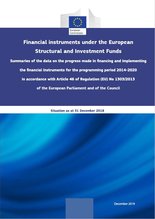Annual summary of data on the use of ESIF financial instruments as at 2018 published by the European Commission

The European Commission has published its annual report summarising data on the use of ESIF financial instruments for the period ending December 2018. The document is entitled ‘Financial instruments under the European Structural and Investment Funds. Summaries of data on the progress made in financing and implementing financial instruments supported by European Structural and Investment Funds (ESIF) – Status as at 31 December 2018’. The summaries are based on data reported by the managing authorities in accordance with Article 46 of the Common Provisions Regulation (EU) No 1303/2013 of the European Parliament and of the Council (CPR). The report presents the progress up to the end of 2018, the fifth year of the 2014-2020 programming period.
This reporting exercise demonstrates that considerable progress has been made in the set-up and implementation of ESIF financial instruments. Overall, 24 Member States reported on financial instruments for 2018. By the end of 2018, the total programme contributions committed to financial instruments were nearly EUR 22.1 billion of which EUR 16.9 billion came from ESIF resources. This is an increase of 17% in programme amounts compared to the 2017 data. Furthermore, compared to the 2017 data, the programme amounts paid to financial instruments increased by 62%, whilst sums committed to final recipients increased by 96% and amounts invested in or paid to final recipients increased by 93%.
The types of financial instruments reported reflect the diversity of national or regional programmes and specificities of the different investment areas supported. The following thematic objectives received the largest shares of funding:
• Small and medium-sized enterprises (SMEs) under TO3: 56.2%,
• Low carbon economy under TO4, i.e. mainly in energy efficiency and renewable energy: 15.5%, and
• Investments in innovation and R&D: 15.4%.
The 2018 results of annual summaries report is published here on the fi-compass website.
It is divided into chapters by the different ESI Funds: ERDF/CF, ESF/YEI, EAFRD and EMFF.
A first preview of the summary of the data was recently presented by Jonathan Denness, Head of Unit, Directorate – General for Regional and Urban Policy, European Commission at the FI Campus 2019 event in Brussels. The presentation can be found here.

